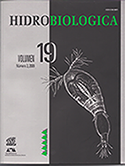Mazculinization of the native cichlid Tenhuayaca, Petenia splendida (Günther, 1862), using Artemia nauplii as vehicle of the steroid 17-? methyltestosterone
Keywords:
Masculinzation, P. splendida, Cichlidae, vehicle, 17-? methyltestosterone.Abstract
At world-wide level the use of steroids to obtain all-male population in cichlids, has been widely used with the objective to avoid the reproduction process and to canalize the energy of the food in weight gain. In this sense, the application of steroids has been commonly through the artificial diets. Nevertheless, for some cichlid such as tenhuayaca or bay snook Petenia splendida, which is considered an appropriate species for aquaculture in the Southeastern of Mexico and Central America, the use of artificial diets during the larval period is not possible, for this reason the use of live preys is required which could be use as vehicle for the steroids. In the present study the production of all-male population was evaluated in P. splendida using Artemia nauplii as vehicle for the steroid 17-? methyltestosterone (MT). For this study the first feeding larvae were fed with Artemia nauplii with MT for 5, 10, 20, 28, 45 and 60 days of feeding, and a control treatment without MT. Significant differences were detected in the masculinization percentage and survival of the larvae fed for 60 days with MT using Artemia nauplii (96% and 85% respectively) compared with the control treatment where only 56% of males and a similar survival of 83% were obtained. For this reason, we conclude that the use Artemia nauplii as vehicle of MT is a suitable alternative to obtain all male production in P. splendida when larvae are feed for 60 days.Downloads
Downloads
Published
How to Cite
Issue
Section
License
Los autores/as que publiquen en esta revista aceptan las siguientes condiciones:
De acuerdo con la legislación de derechos de autor, HIDROBIOLÓGICA reconoce y respeta el derecho moral de los autores, así como la titularidad del derecho patrimonial, el cual será cedido a la revista para su difusión en acceso abierto.
Publicar en la revista HIDROBIOLÓGICA tiene un costo de recuperación de $500 pesos mexicanos por página en blanco y negro (aproximadamente 29 dólares americanos) y $1000 pesos por página a color (aproximadamente 58 dólares americanos).
Todos los textos publicados por HIDROBIOLÓGICA sin excepción se distribuyen amparados bajo la licencia Creative Commons 4.0Atribución-No Comercial (CC BY-NC 4.0 Internacional), que permite a terceros utilizar lo publicado siempre que mencionen la autoría del trabajo y a la primera publicación en esta revista.
Los autores/as pueden realizar otros acuerdos contractuales independientes y adicionales para la distribución no exclusiva de la versión del artículo publicado en HIDROBIOLÓGICA (por ejemplo incluirlo en un repositorio institucional o publicarlo en un libro) siempre que indiquen claramente que el trabajo se publicó por primera vez en HIDROBIOLÓGICA.
Para todo lo anterior, el o los autor(es) deben remitir el formato de Carta-Cesión de la Propiedad de los Derechos de la primera publicación debidamente requisitado y firmado por el autor(es). Este formato se puede enviar por correo electrónico en archivo pdf al correo: enlacerebvistahidrobiológica@gmail.com; rehb@xanum.uam.mx (Carta-Cesión de Propiedad de Derechos de Autor).
Esta obra está bajo una licencia de Creative Commons Reconocimiento-No Comercial 4.0 Internacional.


